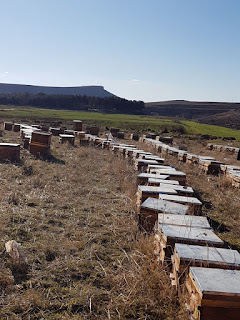Bizi zehirlemesinler! Arılarımız ölüyor!
Bu sözler Mardin Arıcılar Birlik Başkanı Şevket Amca’nın
sözleri. Sevgili dostumuz Carrefour gıda direktörü Ayşin Işıkgece'den dinlemiştim
ilk kez arıları! Türkiye’nin farklı yerlerinde yürüttükleri arı ve bal
projelerini anlattığında arıların yok olması demek ekolojinin dengesinin
bozulması demek olduğunu, arılardan sonra yaşamın sadece dört yıl
sürebileceğini anlatmıştı. Arıları yaşatmamız hepimizin sorumluluğu demişti.
Sürdürülebilir tarımın kilit noktası arılar! Toplam 130 bin bitki türünün
tozlaşmasına etki ederek üremesini sağlıyorlar. Bitkiler döllenmezse bitki
florası tükenecek! Bitkiler tükenirse, hayvanlar ve insanlar da yok olacaklar!
Gördüğünüz gibi doğadaki yasam, karışık ve kırılgan temeller üzerine kurulu.
Bazı etmenler biz farkında olmadan yaşamımızı yüksek ölçüde etkilemekte.
Gördüğünüz gibi birçoğumuzun görevi sadece bal üretmek olduğunu düşündüğümüz
arılar aslında yaşam döngüsünün en önemli başrol oyuncuları. Büyük özveri ile
yaşatmak için uğraştığımız yerel tohumların, arıların yaşamlarını sürdürmeleri
için ne kadar önemli olduğunu da Şevket Amca’dan bugün dinledik. Bu bölgede pamuk
tarlaları bizim bal üretimimiz için arıların önemli besin kaynağı idi. Şimdilerde
ekilen hibrit tohumları sadece pamuk üretmek için programlanmış tohumlar, eski
yerel pamuk tohumlarındaki gibi nektar üretmiyorlar. Arıları beslemiyorlar.
Üstelik hibrite verilen zirai ilaçlar arıları öldürüyor.
Şimdi kovanlarımızı
Karadağ eteklerine taşıyoruz. Çok kıymetli Sarı diken balı üretmeye çalışıyoruz.
Eskiden her kovanda 20-30 kg bal alırken şimdi kovanda en fazla 4 kg bal
alabiliyoruz. Acil bir şeyler yapılmalı! En azından çiftçinin ürününü
bilinçsizce ilaçlama yapmasının önüne geçilmeli ve en önemlisi yerel tohuma
dönülmedir. Projemiz kapsamında Derik’teki
saha çalışmamızı tamamladık. 208 bal üreticisine ulaştık. 25 kadın bal
üreticisi ile Mardin'deki dördüncü
Topraktan Tabağa Tarımsal Kalkınma Kooperatifimizi kurmak için bugün resmi başvurularımızı yaptık. Artık arıları
yaşatmak ve balı bal gibi üretmek için çalışacağız!
They will not poison us! Our bees are dying!
These words belong to Uncle Şevket who is the leader of
Mardin Beekeepeers association. I have first listened to our dear friend
Carrefour’s food director Ayşin Işıkgece about bees. When she told about bee
and honey projects they carry out in different parts of Turkey, she also told
that the disappearance of the bees means the degradation of ecological equilibrium,
and that life after that could last only four years. She said It was our
responsibility to keep the bees alive. They are the key to sustainable agriculture.
They have an impact on pollination and reproduction of 130 thousand plant species.
If the plants are not fertilized, the plant flora will come to an end! If the
plants are exhausted, animals and humans will be extinct. As you see, life in
the nature is based on complex and fragile pedestals. Some factors affect our
life to a great extent without our awareness. As you can see, bees that we
think their mission is only to produce honey, are in fact the most important
actors of the lifecycle. Today we also listened to Uncle Şevket about how
important local seeds that we are trying to enlive with great sacrifice are for
the survival of the bees. Cotton fields in this region were important food
sources of bees for our honey production. Hybrid seeds that have been planted
now are programmed only to produce cotton, they do not produce nectar like the
old local cotton seeds. They do not feed the bees. Moreover, pesticides given for
hybrid seeds kill bees. Now we move our hives to foothills of Karadağ Mountain.
We are trying to produce a very valuable honey called Yellow Thorn. In the
past, we would get 20-30 kg of honey from each beehive, now we can get 4 kg of
honey at most. Something urgent needs to be done! At least the farmer should be
inhibited from insensibly applying pesticides on his product and most
importantly everybody should go back sowing local seeds. Within the scope of
our Project, we completed our fieldwork in Derik. We reached 208 honey
producers. Today we have made our official applications with 25 female honey
producers to establish the fourth From Soil to Plate Agricultural Development
Cooperatives in Mardin. We will now try to keep the bees alive and produce the
honey as honey!




































